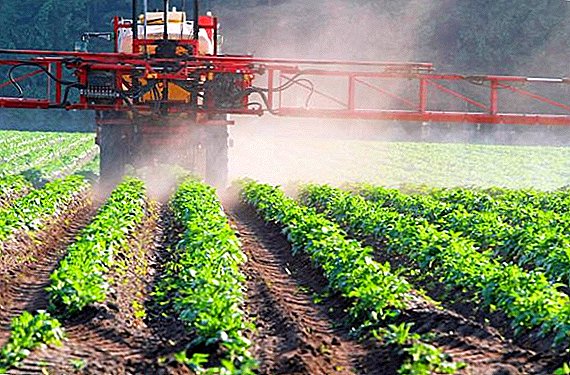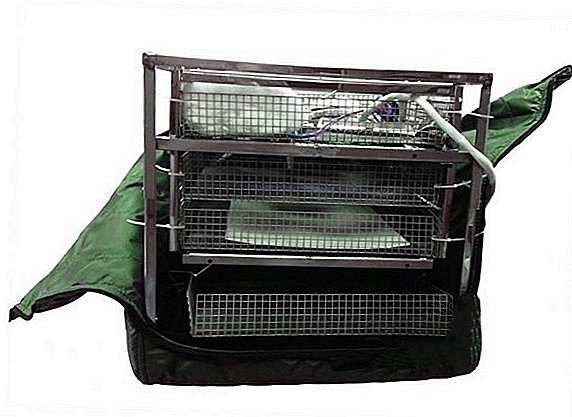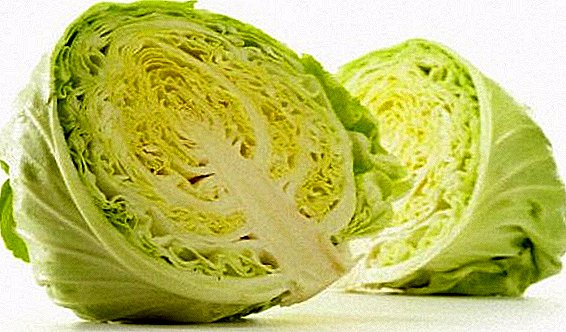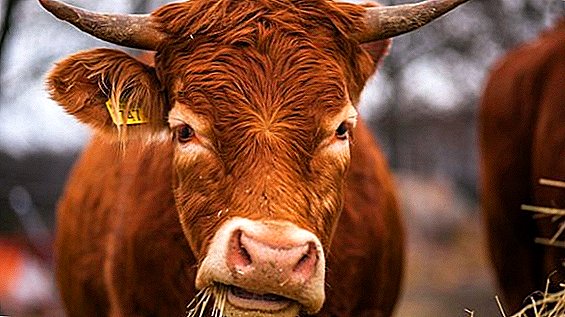 Any farmer should monitor the health of his animals, because the question is not only about preserving the economic indicators and business profitability, but also about elementary safety. There are a number of diseases that are equally dangerous both to animals and people, moreover, a person can become infected with them by eating infected meat. One of these diseases, which poses a deadly threat to both cattle and humans, is spongy encephalopathy, sometimes also called mad cow disease or rabid cow disease.
Any farmer should monitor the health of his animals, because the question is not only about preserving the economic indicators and business profitability, but also about elementary safety. There are a number of diseases that are equally dangerous both to animals and people, moreover, a person can become infected with them by eating infected meat. One of these diseases, which poses a deadly threat to both cattle and humans, is spongy encephalopathy, sometimes also called mad cow disease or rabid cow disease.
What is this disease
Humanity was introduced to this problem recently. In the mid-1980s, several thousand English cows were simultaneously struck by an unknown ailment. Almost simultaneously, similar symptoms were identified in cattle in Ireland, and then in some other countries of Western Europe.
Consider in more detail how to treat such infectious diseases as: bluetongue, leptospirosis, malignant catarrhal fever, anaplasmosis, parainfluenza-3, and actinomycosis.
But England suffered most of all from the strange epidemic: in 1992 tens of thousands of cows died here already.  The signs of the disease were very much like rabies: anxiety, fear of confined space, aggression, light and sound fear, a nervous reaction to touch, desire for solitude, teeth grinding appeared. For this reason, the disease and got its household name, often misleading farmers about its nature.
The signs of the disease were very much like rabies: anxiety, fear of confined space, aggression, light and sound fear, a nervous reaction to touch, desire for solitude, teeth grinding appeared. For this reason, the disease and got its household name, often misleading farmers about its nature.
Important! Spongiform encephalopathy has nothing to do with rabies. These diseases have completely different nature, pathogen, mechanism of infection and course. The only thing that unites them is some symptoms, this is explained by the fact that in one and in the other case the central nervous system and the brain are affected.
Rabies has a viral nature, while the causative agent of spongiform encephalopathy is not a virus, not a bacterium, or even a fungus. It turns out that the disease is caused by a normal protein molecule, which is present on the surface of nerve cells, in the brain and bone marrow of animals and people, but at a certain point for some reason takes on an unusual configuration.  To such a sensational discovery in 1982 came the English biochemist Stanley Prusiner. He called the "twisted" protein molecule causing a deadly brain damage a "prion."
To such a sensational discovery in 1982 came the English biochemist Stanley Prusiner. He called the "twisted" protein molecule causing a deadly brain damage a "prion."
The development of the disease is as follows. "Wrong" prions are attracted to each other, creating a clot or plaque on the nerve cell. As a result, the nerve cell dies, and in its place there is a cavity filled with cell sap, the so-called vacuole. With the development of the disease, such vacuoles fill the entire brain, turning it into a semblance of a sponge (hence spongiform encephalopathy).
Of course, the brain function is irreversibly impaired, and the body affected by the disease dies.
How does the infection occur?
Scientists have long been unable to figure out exactly why the "twisting" of the protein molecules of nerve cells occurs. In the end, an assumption was made, not disproved to the present, that it is enough that one “wrong” prion enters the body so that neighboring molecules begin to reorganize in its image and likeness.  The mechanism of this phenomenon remains not fully understood, but the fact that one “black sheep” somehow infects “the whole herd” is almost beyond doubt.
The mechanism of this phenomenon remains not fully understood, but the fact that one “black sheep” somehow infects “the whole herd” is almost beyond doubt.
With a deeper study of the mechanism of infection, it was found that the source of the disease (the very wrong molecule) most likely got into the body of unfortunate cows with meat and bone meal, added to their food by English farmers. This flour is produced from sheep carcasses, and sheep also suffer from prion ailments.
Unfortunately, the natural process of insemination of cows is long and not always effective. Read about artificial insemination of cows.
Thus, the meat and bones of sick sheep turn into poison, slowly killing other, larger animals.
Answering the question why the meat and bone meal, which has long been added to the cows ’diet, started killing the cows only in a certain period of time, the scientists found out that the outbreak of the epidemic coincided with the introduction of significant changes in the flour manufacturing process, or rather, its simplification by abandoning some stages, further disinfecting raw materials.  And indeed, as soon as the meat and bone meal was excluded from the composition of the feed, the cows began to hurt less, and the epidemic began to decline. But at the same time another problem arose - people began to get sick with spongiform encephalopathy.
And indeed, as soon as the meat and bone meal was excluded from the composition of the feed, the cows began to hurt less, and the epidemic began to decline. But at the same time another problem arose - people began to get sick with spongiform encephalopathy.
Important! Mad cow disease is transmitted to humans through the meat of a sick cow, which it eats. There is no infection from direct contact with the animal.
This feature of the transmission of the disease means that the nature of the epidemic takes spongy encephalopathy, not because the animals infect each other, but because they eat the same food.
If a cow infected with “imaginary rabies” has got into the herd, it will not infect its companions, but the disease can be transmitted by the intrauterine method, that is, calves born of such a cow will most likely also be sick. 
Forms and signs of rabies in cattle
One of the main problems associated with diagnosis and, accordingly, with the very possibility of treating spongiform encephalitis, is that this disease has a very long incubation period. In cows, it can be from 2.5 to 8 years, and in humans, the disease has a latent form even longer, sometimes up to 30 years.
But when the disease makes itself felt, it progresses rapidly and is not accompanied by temporary improvements in the condition.
Did you know? The identification of a new deadly disease of cows caused a real panic. British farmers were forced to slaughter more than 3.5 million cows, and, most likely, the vast majority of them were completely healthy. Many countries (including Russia) have banned the importation of meat from the UK into their territory, which caused Foggy Albion’s agriculture losses of billions of pounds.
It is accepted to distinguish 2 forms of the disease:
- acquired (sometimes it is also called variant or sporadic, since it occurs in individuals and is not an epidemic);
- hereditary (the animal is infected in the womb of the sick mother and is born with the presence of the disease).
 With regard to the symptoms of the disease, they can be divided into "violent", associated with changes in the behavior of a sick cow, and those that characterize the general condition of the animal.
With regard to the symptoms of the disease, they can be divided into "violent", associated with changes in the behavior of a sick cow, and those that characterize the general condition of the animal.Exuberant
A patient with spongy encephalopathy of an animal has an unreasonable fear, however, if ordinary viral rabies is characterized by severe hydrophobia, then the prion infection manifests itself by an acute negative reaction to any stimuli - light, noise, bodily contact.
Farmers are advised to familiarize themselves with the best breeds of cows: Sychevskaya, Belgian blue, Hereford, Simmental, Dutch, Holstein and Ayrshire.
A cow can, for no reason at all, kick the master, lose the leading position in the herd, begin to tremble all over, run into obstacles. In general, this block of symptoms is very similar to the clinical picture of rabies. 
Calm
In addition to obvious changes in behavior, spongiform encephalopathy can also be recognized for several other, "calm" symptoms, which include:
- impaired motility and coordination of movements (ataxia): this symptom sometimes lasts several weeks, and in other cases extends over months;
- limping gait;
- frequent movement of the ears;
- nose licking;
- scratching the head (an animal with this purpose may rub against various objects or even try to reach the head with its foot);
- blurred vision;
- twitching and involuntary muscle contraction, accompanied by strong painful sensations;
- weight loss (with continued appetite);
- reduced milk production;
- in the final stages - hind limb failure, coma and death.

In humans, the characteristic signs of spongiform encephalopathy are memory loss, dementia and other disorders of brain activity, depression and insomnia, tingling in the extremities, but the cow has these symptoms (of course, also occurring) is difficult to recognize.
Important! Unlike true rabies, with spongiform encephalopathy, there is never an increase in body temperature. For this symptom, you can distinguish 2 diseases similar in clinical picture.
Diagnostics
Clinical and epizootological information does not accurately diagnose spongy encephalopathy, since its symptoms have similar features to many other diseases of cattle, and not only rabies applies to them.
To date, there are 2 main ways to diagnose spongiform encephalopathy:
- biochemical (histological);
- immunological.
 Biochemical method of diagnosis The first method involves the study under an electron microscope of a slice of a brain region in order to establish voids (vacuoles) and prion plaques forming threads.
Biochemical method of diagnosis The first method involves the study under an electron microscope of a slice of a brain region in order to establish voids (vacuoles) and prion plaques forming threads.We recommend that you find out: how to choose the right milk cow, the structure of the udder of the cow, and also consider the characteristics of some milk coolers.
Immunological diagnosis involves the use of specific antibodies that interact with deformed prions, reacting with them, which can be detected. There is a reaction - the analysis is positive, there is no reaction - there is no disease. This method is definitely more reliable and informative than visual inspection.
The only "small" problem is that it can only be carried out on dead animals. In other words, the immunological method of diagnosis is good when it is necessary to check whether beef can be eaten, for example, brought from countries that are at risk for mad cow disease.  Immunological method of diagnosis
Immunological method of diagnosis
It is this method that is used today in Western Europe, where a meat processing plant, at the stage of preparing cow carcasses for processing, carries out their preliminary analysis of spongiform encephalopathy; it takes about 10 hours.
However, experiments to diagnose people for the presence of latent forms of the disease are already underway - a spinal fluid or a piece of tissue taken from the throat is taken for analysis.
Is it possible to cure
Unfortunately, timely diagnosis is not needed for treatment, but only for maintenance therapy (in humans) and decision-making on the possibility of eating meat (for cows).
Important! Spongiform encephalopathy is incurable and in 100% of cases leads to death. Moreover, in contrast to viral rabies, vaccination against this disease does not exist (given the specific nature of the pathogen, most likely, it is in principle impossible).
In humans, death from "mad cow disease" occurs in the period from six months to one year after the first symptoms of the disease have been detected. However, given the very long incubation period, if a problem is detected in time, its development can be slightly delayed.
Can a person get infected from sick animals
100% mortality and the inability to vaccinate makes spongiform encephalopathy extremely dangerous, even though the likelihood of a person receiving such an exotic disease cannot be called high.
So, today, about 80 (according to other data - 200) people have died from mad cow disease in the world, and these figures are comparable to the statistics of deaths from "real" rabies, which, although fatal, only if no timely measures are taken vaccine administration.  However, it must be understood that the number of deaths from spongiform encephalopathy may increase significantly in the future due to those who ate the meat of infected cows before the dangerous disease was recognized (if the alarm was first sounded in 1985, and the development of an illness in a person can last 30 years, it is likely that the worst consequences of the infection have not yet manifested themselves).
However, it must be understood that the number of deaths from spongiform encephalopathy may increase significantly in the future due to those who ate the meat of infected cows before the dangerous disease was recognized (if the alarm was first sounded in 1985, and the development of an illness in a person can last 30 years, it is likely that the worst consequences of the infection have not yet manifested themselves).
It is important to know that eating the meat of a sick animal, including a wild one, such as a deer or an elk, is indeed the most likely way to infect humans with mad cow disease (unlike the real rabies virus, the causative agent of spongiform encephalopathy is not found in animal saliva). However, more exotic ways of infection are possible.
Did you know? Some tribes of New Guinea, who still use cannibalism during ritual ceremonies, were infected with “mad cow disease” by eating human meat. There are also cases of infection of people who have undergone transplantation or blood transfusion, that is, from sick donors. For this reason, by the way, in the UK today donor blood from people living in the regions mentioned as centers of the spread of "rabid cow disease" is not accepted.
In addition to meat, sources of infection can also be milk and dairy products, and we are talking not only about cow, but also sheep and goat milk. 
Mad cow prevention
In the absence of a vaccine, prevention is the only possible way to prevent the inevitable death from mad cow disease. And precautionary measures should apply not only to farms where cows and other susceptible livestock are kept, but also enterprises processing and selling their meat and milk, and final consumers of these products.
You will certainly be useful to know the causes of blood in the milk of a cow.
For countries where the situation with mad cow disease looks good (fortunately, Russia, Ukraine and Belarus are among those; however, as skeptics say, the problem has bypassed us rather because domestic breeders simply cannot afford to buy meat - bone meal produced in England and feed their boars with local hay and mixed fodder), preventive measures are reduced to following a few simple rules:
- Restrictions on the importation of meat products from the states or territories where even sporadic encephalopathy was observed. This should apply not only to meat and offal, but also semi-finished products, embryos, sperm, biological tissues, meat and bone meal and other feed and feed additives of animal origin, technical fat, the so-called intestinal raw materials, cheeses and other dairy products.
- Careful inspection of all breeding individuals imported into the country, especially from England and other European countries.
- Failure to use as feed additives meat and bone meal made from sheep and cattle carcasses.
- Acquisition of feed and feed additives only with the presence of an appropriate certificate confirming that the products pass a spongiform encephalopathy test.
- Obligatory laboratory research of the brain of sheep and cattle that died from an unknown cause, as well as slaughtered carcasses for sale.
 Laboratory study of the brain of cattle as a measure for the prevention of mad cow disease
Laboratory study of the brain of cattle as a measure for the prevention of mad cow diseaseIn the United Kingdom, Ireland, Germany and other countries that are unfavorable from the point of view of mad cow disease, prevention has been put on a more serious level. The most radical measure, to which, nevertheless, many residents of these countries have long resorted, is a complete rejection of the use of beef, lamb, goat meat and lamb.
With regard to government measures to combat the deadly disease, the British, for example, have developed a special system for identifying cases of mad cow disease. In the country, random checks of meat products intended for sale are carried out periodically.
Did you know? Ordinary protein molecules begin to fold, turning into a gel, at a temperature of 65-70 ° C, but the agent of mad cow disease (a pathogenic prion that has already changed its natural configuration) is destroyed at a temperature above 1000 ° C! Thus, the usual, even very careful, heat treatment of meat contaminated with mad cow disease does not make it fit for human consumption. It is interesting to note that the normal rabies virus dies instantly when heated to 100 ° C, and within 2 minutes at 80 ° C.
Back in 1997, in the United States of America, the Food and Drug Administration (FDA), banned the inclusion of animal proteins in feed for cattle and small ruminants.
Thus, unfortunately, little depends on us. If the meat of an animal infected with mad cow disease somehow falls on the table, the infection and subsequent death (in the long run, but without options) awaits us inevitably. While we remain at home, there is no particular cause for concern, except that meat and dairy products should be purchased only from reputable manufacturers.
On the other hand, although spongiform encephalopathy is an English disease transmitted to some countries in Western Europe, the situation there has already been taken under strict state control.
Therefore, any tourist today can enjoy the fragrant steak in a good restaurant there without any fear, but it is still better to refuse street shawarma and other meat dishes of dubious origin for their own safety.












